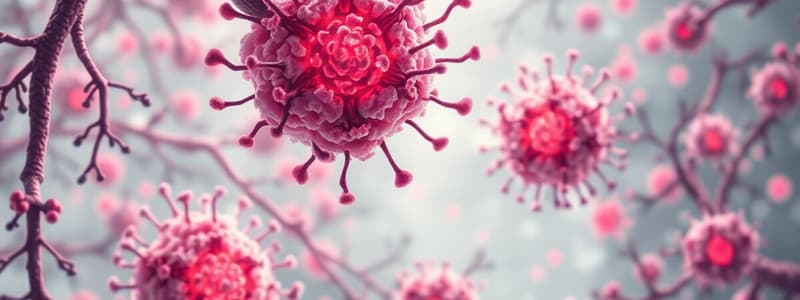Podcast
Questions and Answers
In Type I hypersensitivity, which cellular event is most crucial for mast cell degranulation following IgE cross-linking?
In Type I hypersensitivity, which cellular event is most crucial for mast cell degranulation following IgE cross-linking?
- Enhanced activity of endoplasmic reticulum Ca2+-ATPases (SERCA)
- Increased calcium ion (Ca++) influx (correct)
- Decreased intracellular cAMP levels
- Inhibition of phospholipase C (PLC) activation
A researcher is investigating potential therapeutic targets for Type I hypersensitivity reactions. Which mediator would be the MOST effective to target to prevent both early and late-phase reactions?
A researcher is investigating potential therapeutic targets for Type I hypersensitivity reactions. Which mediator would be the MOST effective to target to prevent both early and late-phase reactions?
- Leukotrienes because they are more potent than histamine and contribute to prolonged symptoms (correct)
- Tryptase, due to its role in proteolysis and tissue damage
- ECF-A, due to its effects on attracting eosinophils and neutrophils
- Histamine alone, due to its rapid effects on vasodilation
A patient with severe seasonal allergies is considering immunotherapy. What is the primary immunological mechanism by which immunotherapy aims to reduce allergic symptoms?
A patient with severe seasonal allergies is considering immunotherapy. What is the primary immunological mechanism by which immunotherapy aims to reduce allergic symptoms?
- Increase the production of IgE to outcompete the allergen.
- Stimulate the long-term production of histamine desensitizing mast cells.
- Induce a shift toward allergen-specific IgG4 antibody production, blocking IgE-mediated activation. (correct)
- Permanently suppress the Th2 immune response and IL-4 production.
Which diagnostic test would be most appropriate to distinguish between a Type I hypersensitivity reaction and other inflammatory skin conditions?
Which diagnostic test would be most appropriate to distinguish between a Type I hypersensitivity reaction and other inflammatory skin conditions?
A 74-year-old male was accidentally transfused with 500 mL blood during open right hemicolectomy. Immediately after the transfusion, the patient experienced a hypotension episode followed by acute hemolytic reaction, disseminated intravascular coagulation, and acute kidney injury. Considering the acute hemolytic reaction, what is the underlying mechanism of red blood cell destruction in this scenario?
A 74-year-old male was accidentally transfused with 500 mL blood during open right hemicolectomy. Immediately after the transfusion, the patient experienced a hypotension episode followed by acute hemolytic reaction, disseminated intravascular coagulation, and acute kidney injury. Considering the acute hemolytic reaction, what is the underlying mechanism of red blood cell destruction in this scenario?
Erythroblastosis fetalis happens when fetal blood may enter to maternal circulation and produce antibody against Rh antigen. At the 2nd birth, the antibody will cross the placenta and become attached to Rh antigen on the surface of RBCs of the fetus and extravascular haemolysis occur and the infant show anemia and jaundice at first day then hepatosplenomegally and bilirubin encephalopathy. Which mechanism primarily mediates the destruction of fetal red blood cells in Erythroblastosis fetalis?
Erythroblastosis fetalis happens when fetal blood may enter to maternal circulation and produce antibody against Rh antigen. At the 2nd birth, the antibody will cross the placenta and become attached to Rh antigen on the surface of RBCs of the fetus and extravascular haemolysis occur and the infant show anemia and jaundice at first day then hepatosplenomegally and bilirubin encephalopathy. Which mechanism primarily mediates the destruction of fetal red blood cells in Erythroblastosis fetalis?
In the context of Type II hypersensitivity reactions, which statement accurately describes the role of haptens?
In the context of Type II hypersensitivity reactions, which statement accurately describes the role of haptens?
A patient presents with fever, joint pain, and skin rash after receiving a therapeutic antibody. Complement levels are decreased, and immune complexes are detected in the serum. Which hypersensitivity mechanism is most likely responsible for these symptoms?
A patient presents with fever, joint pain, and skin rash after receiving a therapeutic antibody. Complement levels are decreased, and immune complexes are detected in the serum. Which hypersensitivity mechanism is most likely responsible for these symptoms?
In Type III hypersensitivity reactions, why do immune complexes tend to deposit in specific tissues like the kidney glomeruli and joint synovium?
In Type III hypersensitivity reactions, why do immune complexes tend to deposit in specific tissues like the kidney glomeruli and joint synovium?
Which of the following mechanisms contributes to tissue damage in Type III hypersensitivity reactions?
Which of the following mechanisms contributes to tissue damage in Type III hypersensitivity reactions?
What is the primary role of IL-12 in Type IV hypersensitivity reactions?
What is the primary role of IL-12 in Type IV hypersensitivity reactions?
A skin biopsy from a patient with a suspected Type IV hypersensitivity reaction reveals a dense perivascular infiltrate comprised primarily of lymphocytes and macrophages. Which immunological event initiated this response?
A skin biopsy from a patient with a suspected Type IV hypersensitivity reaction reveals a dense perivascular infiltrate comprised primarily of lymphocytes and macrophages. Which immunological event initiated this response?
In a delayed-type hypersensitivity reaction, such as the tuberculin skin test, what is the role of chemokines like IL-8 and monocyte chemotactic and activating factor (MCAF)?
In a delayed-type hypersensitivity reaction, such as the tuberculin skin test, what is the role of chemokines like IL-8 and monocyte chemotactic and activating factor (MCAF)?
What is the significance of measuring total IgE and specific IgE antibodies using ELISA in the context of hypersensitivity diagnosis?
What is the significance of measuring total IgE and specific IgE antibodies using ELISA in the context of hypersensitivity diagnosis?
In managing Type I hypersensitivity, why are leukotriene receptor blockers often more effective than antihistamines for treating late-onset allergic symptoms?
In managing Type I hypersensitivity, why are leukotriene receptor blockers often more effective than antihistamines for treating late-onset allergic symptoms?
Flashcards
Hypersensitivity Types
Hypersensitivity Types
Hypersensitivity reactions are classified into Type I, Type II, Type III (immediate), and Type IV (delayed)
Type I Hypersensitivity: Inhalants
Type I Hypersensitivity: Inhalants
Pollen grains and fungal allergens.
Type I Hypersensitivity: Injectants
Type I Hypersensitivity: Injectants
Drugs
Type I Hypersensitivity: Contact
Type I Hypersensitivity: Contact
Antiseptic spray.
Signup and view all the flashcards
Type I Hypersensitivity
Type I Hypersensitivity
Immediate hypersensitivity. The reaction involves: skin, eyes, nasopharynx bronchopulmonary tissues and gastrointestinal track
Signup and view all the flashcards
IgE Affinity
IgE Affinity
IgE has very high affinity for its receptor on mast cells and basophils.
Signup and view all the flashcards
Mast Cell Degranulation
Mast Cell Degranulation
Cross-linking of IgE Fc-receptor triggers mast cell degranulation, preceded by increased Calcium influx.
Signup and view all the flashcards
Diagnostic Tests: Immediate Hypersensitivity
Diagnostic Tests: Immediate Hypersensitivity
Skin (prick and intradermal) tests.
Signup and view all the flashcards
Measuring IgE
Measuring IgE
Measurement of total IgE and specific IgE antibodies measured by ELISA
Signup and view all the flashcards
Hypersensitivity Treatment
Hypersensitivity Treatment
Avoidance of exposure, symptomatic treatment, and immunotherapy
Signup and view all the flashcards
Exposure Avoidance Dust Mites
Exposure Avoidance Dust Mites
Cover mattresses and pillows with dust mite resistant covers
Signup and view all the flashcards
Exposure Avoidance Fungi
Exposure Avoidance Fungi
Removing indoor plants promotes mould growth and drying or removing wet carpets.
Signup and view all the flashcards
Antihistamines
Antihistamines
blocks histamine receptors.
Signup and view all the flashcards
Chromolyn Sodium
Chromolyn Sodium
inhibits mast cell degranulation, by inhibiting Ca++ influx.
Signup and view all the flashcards
Immunotherapy Definition
Immunotherapy Definition
Administration of gradually increasing doses of allergen extracts at regular intervals over a period of years.
Signup and view all the flashcardsStudy Notes
Hypersensitivity Classification
- Hypersensitivity reactions are classified into four types: Type I, Type II, Type III, and Type IV
Type I Hypersensitivity
- Inhalants, injectants and contact allergens can cause Type I hypersensitivity
- This type is also known as immediate hypersensitivity
- Reactions can manifest with the skin, eyes, nasopharynx, bronchopulmonary tissues, and the gastrointestinal tract
Mechanism of Type I Hypersensitivity
- The mechanism involves the production of IgE in response to certain antigens/allergens
- IgE exhibits a very high affinity for its receptors on mast cells and basophils
- Subsequent exposure to the same allergen cross-links cell-bound IgE and triggers the release of various active substances
- Cross-linking of IgE Fc-receptors is important in triggering mast cell degranulation, which is preceded by increased Ca++ influx
Mediators of Immediate Hypersensitivity
- Preformed mediators in granules include histamine, tryptase, and ECF-A that cause bronchoconstriction, vascular permeability, proteolysis, and attract eosinophils and Neutrophils, respectively
- Newly formed mediators include leukotriene B4, leukotriene C4/D4, and prostaglandin D2 that are basophil chemoattractants, causes histamine release and edema and pain, respectively
Diagnostic tests for Immediate Hypersensitivity
- Skin (prick and intradermal) tests are used to diagnose
- Measurement of Total IgE and specific IgE antibodies is measured by ELISA
Treatment of Immediate Hypersensitivity
- Complete avoidance of exposure is one method
- Symptomatic treatment can be performed
- Immunotherapy can be used
Avoidance of Exposure
- For dust mite allergens, cover mattresses and pillows with dust mite-resistant covers
- For fungal allergens, remove indoor plants, remove wet carpets and increase ventilation
Symptomatic Treatment
- Use antihistamines that block histamine receptors
- Prescription of chromolyn sodium inhibits mast cell degranulation by inhibiting Calcium influx
- Late-onset allergic symptoms are treated with leukotriene receptor blockers or cyclooxygenase inhibitors
- Bronchodilators can be used for short-term relief from bronchoconstriction
Immunotherapy
- Gradually increasing doses of allergen extracts are administered at regular intervals over a period of years
- It is administered by injection or sublingually
- This teaches the immune system to tolerate the allergen and causes the production of 'regulatory' immune cells
- This stops the production of IgE, rises in allergen-specific IgG4 antibodies with blocking activity through the inhibition of allergen-induced, IgE-mediated release of inflammatory mediators from mast cells
Type II Hypersensitivity
- This is also known as cytotoxic hypersensitivity; it affects a variety of organs and tissues
- Antigens are normally endogenous
- This type is primarily mediated by IgM or IgG classes
- Complement-mediated lysis, phagocytes, and killer cells all play a role ADCC (Antibody-dependent cell-mediated cytotoxicity)
RBC Lysis - Types of Type II Hypersensitivity
- Incompatible blood transfusion has effects like intravascular hemolysis from complement manifesting as nausea, fever, and back pain
- Erythroblastosis fetalis occurs in Rh-negative mothers giving birth to Rh-positive infants; fetal blood enters maternal circulation, producing antibodies against Rh antigen.
- Autoimmune hemolytic disease can occus
WBCs Lysis - Types of Type II Hypersensitivity
- Granulocytopenia
- SLE (Systemic Lupus Erythematosus)
Platelet Destruction - Types of Type II Hypersensitivity
- Thrombocytopenia
Type III Hypersensitivity
- It's also known as immune complex hypersensitivity
- IgG and IgM mediate this
- The antigen may be exogenous or endogenous
Mechanism for Type III Hypersensitivity
- The Ag is soluble and not attached to the organ involved
- Soluble Ag-antibody complexes penetrate the endothelium of blood vessels and are deposited on the vascular basement membrane
- Complement and chemotactic factors like C5a are released, attracting neutrophils which infiltrate the area and release lysosomal enzymes, leading to destruction of the basement membrane
Types of Type III Hypersensitivity
- Arthus reaction
- Serum sickness
- Hypersensitivity pneumonitis
- Poststreptococcal glomerulonephritis
- Autoimmune disease: RA , SLE
Type IV Hypersensitivity
- Is also known as cell-mediated or delayed-type hypersensitivity
- Tuberculin (Montoux) reaction, peaking 48 hours after antigen injection, is a classical example
- The lesion is characterized by induration and erythema
Mechanism for Type IV Hypersensitivity
- CD4+ helper T cells recognize antigen in a complex with Class II MHC
- Antigen-presenting cells, like macrophages, secrete IL-12 to stimulate proliferation of CD4+ Th1 cells
- CD4+ T cells secrete IL-2 and interferon gamma, mediating the immune response
- Activated CD8+ T cells directly destroy target cells -Chemokines, collectively lead to macrophage activation, resulting in local tissue reaction usually maximal in 48-72 hours
Case scenario Summary
- A 74-year-old male was accidentally transfused during surgery and experienced hypotension, acute hemolysis, disseminated intravascular coagulation, and acute kidney injury.
Studying That Suits You
Use AI to generate personalized quizzes and flashcards to suit your learning preferences.




